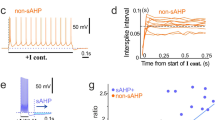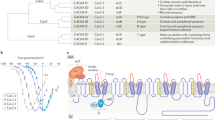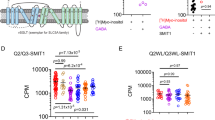Abstract
EXCITATORY amino acids mediate fast synaptic transmission in the central nervous system through the activation of at least three distinct ionotropic receptors: N-methyl-D-aspartate (NMDA), the α-amino-3-hydroxy-5-methyl-isoxasole-4-propionate(AMPA)/ quisqualate (QUIS) and the kainate subtypes (for reviews, see refs 1, 2). They also activate the additional QUIS 'metabotropic' receptor (sensitive to trans-l-amino-cyclopentyl-l,3-dicarboxylate, ACPD) linked to inositol phospholipid metabolism3–5. We have used hippocampal slice cultures to study the electrophysio-logical consequences of the metabotropic response. We find that activation of an ACPD-sensitive QUIS receptor produces a 'slow' excitation of CA3 pyramidal cells, resulting from depression of a Ca2+-dependent K+ current and a voltage-gated K+ current. Combined voltage-clamp and microfluorometric recordings show that, although these receptors can trigger an increase in intracellular Ca2+ concentration6–8, suppression of K+ currents is independent of changes in intracellular Ca2+. These effects closely resemble those induced by activating muscarinic acetylcholine receptors in the same neurons and suggest that excitatory amino acids not only act as fast ionotropic transmitters but also as slow neuromodulatory transmitters.
This is a preview of subscription content, access via your institution
Access options
Subscribe to this journal
Receive 51 print issues and online access
$199.00 per year
only $3.90 per issue
Buy this article
- Purchase on Springer Link
- Instant access to full article PDF
Prices may be subject to local taxes which are calculated during checkout
Similar content being viewed by others
References
Mayer, M. L. & Westbrook, G. L. Prog, neurobiol. 28, 197–276 (1990).
Monaghan, D. T., Bridges, R. J. & Cotman, C. W. A. Rev. pharmac. Toxic. 29, 365–402 (1989).
Sugiyama, H., Ito, I. & Hirono, C. Nature 325, 531–533 (1987).
Nicoletti, F. et al. J. Neurochem. 46, 40–46 (1986).
Sladeczek, F., Pin, J.-P., Récasens, M., Bockaert, J. & Weiss, S. Nature 317, 717–719 (1985).
Furuya, S., Ohmori, H., Shigemoto, T. & Sugiyama, H. J. Physiol., Lond. 414, 539–548 (1989).
Murphy, S. N. & Miller, R. J. Proc. natn. Acad Sci. U.S.A. 85, 8737–8741 (1988).
Murphy, S. N. & Miller, R. J. Molec. Pharmac. 35, 671–680 (1989).
Lester, R. A. J. & Jahr, C. E. Neuron 4, 741–749 (1990).
Schwartzkroin, P. A. & Stafstrom, C. E. Science 210, 1125–1126 (1980).
Hotson, J. R. & Prince, D. A. J. Neurophysiol. 43, 409–419 (1980).
Alger, B. E. & Nicol, R. A. Science 210, 1122–1124 (1980).
Ambrosini, A. & Meldolesi, J. J. Neurochem. 53, 825–833 (1989).
Do, K. Q., Herrling, P. L., Streit, P., Turski, W. A. & Cuénod, M. J. Neurosci. 6, 2226–2234 (1986).
Keller, H. J., Do, K. Q., Zollinger, M., Winterhalter, K. H. & Cuénod, M. J. Neurochem. 52, 1801–1806 (1989).
Charpak, S., Knöpfel, T., Do, K. Q. & Gähwiler, B. H. Soc. Neurosci. Abstr. 15, 948 (1989). (Abstract).
Stratton, K. R., Worley, P. F. & Baraban, J. M. Eur. J. Pharmac. 173, 235–237 (1989).
Cherubini, E., Rovira, C., Ben-Ari, Y. & Nistri, A. Epilepsy Res. 5, 18–27 (1990).
Palmer, E., Monaghan, D. T. & Cotman, C. W. Eur. J. Pharmac. 166, 585–587 (1989).
Lancaster, B. & Adams, P. R. J. Neurophysiol. 55, 1268–1282 (1986).
Cole, A. E. & Nicoll, R. A. Science 221, 1299–1301 (1983).
Madison, D. V. & Nicoll, R. A. Nature 299, 636–638 (1982).
Haas, H. L. & Konnerth, A. Nature 302, 432–434 (1983).
Halliwell, J. V. & Adams, P. R. Brain Res. 250, 71–92 (1982).
Brown, D. A. & Adams, P. R. Nature 283, 673–676 (1980).
Brown, D. A. in Ion Channels Vol. 1 (ed Narahashi, T.) 55–94 (Plenum, New York, 1988).
Knöpfel, T., Vranesic, I., Gähwiler, B. H. & Brown, D. A. Proc. natn. Acad. Sci. U.S.A. 87, 4083–4087 (1990).
Baraban, J. M., Snyder, S. H. & Alger, B. E. Proc. natn. Acad. Sci. U.S.A. 2538–2542 (1985).
Dutar, P. & Nicoll, R. A. J. Neurosci. 8, 4214–4224 (1988).
Gähwiler, B. H. J. neurosci. Meth. 4, 329–342 (1981).
Author information
Authors and Affiliations
Rights and permissions
About this article
Cite this article
Charpak, S., Gähwiler, B., Do, K. et al. Potassium conductances in hippocampal neurons blocked by excitatory amino-acid transmitters. Nature 347, 765–767 (1990). https://doi.org/10.1038/347765a0
Received:
Accepted:
Issue Date:
DOI: https://doi.org/10.1038/347765a0
Comments
By submitting a comment you agree to abide by our Terms and Community Guidelines. If you find something abusive or that does not comply with our terms or guidelines please flag it as inappropriate.



